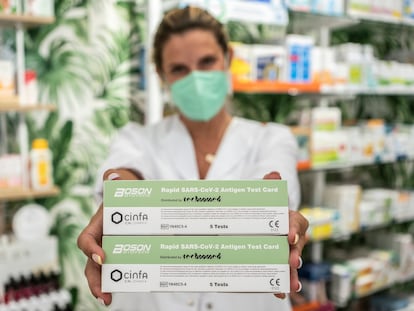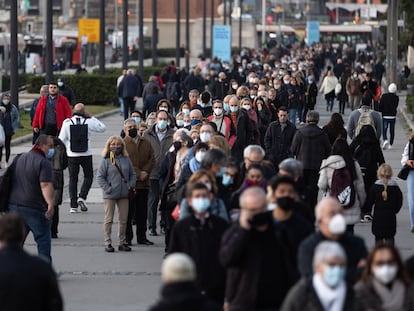Omicron variant spreads across Spain: In Madrid, it already accounts for 30% of diagnosed cases
In a bid to curb the transmission, the Catalan government has announced that all close contacts will have to quarantine even if they are fully vaccinated

The circulation of the omicron variant of the coronavirus, which was first identified a month ago in South Africa and Botswana, is speeding up in Spain.
In the northwestern region of Catalonia, the new strain accounts for 20% of all cases, according to the Catalan health department. In a bid to curb the spread, the Catalan regional government announced on Friday that starting Monday all close contacts of coronavirus cases will have to quarantine even if they are fully vaccinated.
The Madrid region has also detected a surge in omicron cases. According to healthcare sources, the omicron variant accounts for more than 30% of the cases diagnosed in hospitals in the region. This percentage falls to between 7 and 13% in other healthcare centers located in Andalusia, although all sources consulted by EL PAÍS suggest that the upward trend is similar, but simply with several days of delay, and that it is likely that this new form of the virus will become dominant in just a few weeks across the country, and much earlier in Madrid.
This data is based on the PCR tests being used in hospitals, which are able to detect suspect omicron cases according to the presence or not of mutations that are specific to the strain. The results must be later confirmed via genetic sequencing, something that is happening in practically all cases.
The complexity of this process, which can take as long as 10 days to complete, is delaying the official tracking of cases of the new variant. Health Minister Carolina Darias, for example, stated on Thursday in Congress that 40 cases so far had been confirmed in Spain by sequencing, a number that rises to 51 according to data sent by Spain to the European Center for Disease Prevention and Control (ECDC). A number of microbiology services at public hospitals, however, have already detected more cases than this alone.
“The speed with which the omicron strain is spreading is much greater than what we detected with delta or alpha,” explains chief virologist at the Ramón y Cajal Hospital in Madrid, Juan Carlos Galán, in reference to previously identified variants of the coronavirus. The hospital is analyzing the tests carried out from a population of around 650,000 people in the northeast of the Spanish capital. The first omicron case detected in this hospital was taken from a sample on December 3. Last week, the omicron cases identified via PCR were around 17% of the total, a percentage that had risen to “between 30 and 32%” by this Thursday, according to Galán.
Lola Folgueira, from the microbiology service at the Doce de Octubre Hospital in Madrid, says that “43% of the positive PCR samples” are from the new variant, while sources from other hospitals in the region, such as the Gregorio Marañón in central Madrid and the Príncipe de Asturias in neighboring city Alcalá de Henares, confirm that the proportion of the new variant detected is “similar” to that at the Ramón y Cajal.
Spain’s regions – which are in charge of their own healthcare systems, coronavirus restrictions and vaccination programs – are not offering detailed data yet, until they have completed the genetic sequencing of the samples. The Madrid regional health chief, Enrique Ruiz Escudero, explained on Wednesday that the region has 10 confirmed omicron cases and 154 that are being studied. “We need to remember that not everything is being sequenced, random tests are done, and the transmission of omicron according to the tests carried out is high,” he explained.
The speed with which the omicron strain is spreading is much greater than what we detected with delta or alphaJuan Carlos Galán, chief virologist at the Ramón y Cajal Hospital in Madrid
In Barcelona, the head of the microbiology service at the Clínic Hospital, Jordi Vila, explains that the new variant is “gaining ground significantly.” The latest tests carried out, on a sample of 43 cases, detected three that were omicron – 7% of the total. “We detected them via PCR, but the results are very trustworthy because we use an algorithm with two PCRs that identifies two mutations in the S protein,” Vila explains.
Federico García, the head of microbiology at the San Cecilio Hospital in Granada, Andalusia, says that “the omicron variant is demonstrating a higher capacity for transmission than previous ones and its growth is considerable.” García would not provide precise data before the Andalusia regional government does, although health sources from the region have confirmed that in some areas “omicron already accounts for between 10 and 13% of the new positive cases.”
In Navarre, the general director of Public Health, Carlos Artundo, summed up on Thursday the invasion of the new form of the virus with the following words: “It’s going through the roof.” This region, in northern Spain, is currently registering more than 1,300 cases per 100,000 inhabitants over 14 days. That’s the highest incidence in Spain right now. The regional authorities this week announced that they would be hiring a dozen or so contact tracers in order to deal with the rise in cases. Murcia, another of the regions that is detecting a significant rise in omicron cases, will be taking on 60 tracers.
For now, omicron cases are not proving to be very serious, although the health chiefs consulted by EL PAÍS believe that it is still too early to say whether this situation will continue because until now the new variant is circulating mainly among young and vaccinated people. “We still need to know what will happen when people who get infected are older or at greater risk,” explains Jordi Vila. In any case, they warn, if the number of cases continues to grow exponentially, sooner or later there will be a rise in hospitalizations and deaths, as the ECDC warned on Wednesday.
Fernando González Candelas, a genetics professor at the University of Valencia and a researcher at the Fisabio Foundation, points out that the rise in cases caused by omicron is happening on top of “those caused by the delta variant, which continue to be in the majority and have been on a clear upward rise in Spain since October.” For this expert, what is likely to happen is that this drives an increase in the incidence in the following weeks, “as has happened in other countries such as the United Kingdom and Denmark.”
We still need to know what will happen when people who get infected with omicron are older or at greater riskJordi Vila, head of the microbiology service at Clínic Hospital
In the last two weeks, the cumulative incidence over 14 days has risen in Spain from 217 cases per 100,000 inhabitants to 473, while in the Madrid region the number has gone up from 150 to 392. In the latter case, there are other clear signs of a spike, such as primary healthcare centers on the brink of being overwhelmed and unable to attend all patients in a timely fashion, meaning that the true incidence could be even greater.
The omicron variant has spread rapidly across the whole planet in less than two months. According to the daily report from the ECDC, nearly 16,000 cases have been detected via genetic sequencing in 85 countries. In the EU, the country with the highest number of cases of the new variant reported so far is Denmark, with 383, followed by France, with 170. No deaths in the EU so far have been attributed to omicron.
The ECDC warned on Wednesday that community transmission of omicron is already happening in all countries and predicted an explosion of cases in the coming weeks. Because of this, the body is calling for vaccination rates to be stepped up, given that this is still the best way to bring down the number of serious cases, as well as measures to remain in place such as masks and limiting social meetings. The ECDC also called for hospitals to prepare for a possible major spike in admissions.
Spain reports 28,900 new coronavirus cases
The Spanish Health Ministry reported 28,900 new coronavirus cases in Spain on Thursday, in its daily report on the pandemic. The data also included 48 more Covid-related deaths. The cumulative incidence rose 31 points compared to the day before, to 473 cases per 100,000 inhabitants over the previous 14 days.
Since the start of the pandemic, 5,422,168 official infections have been recorded, and the death toll stands at 88,667 people.
Pressure on Spain’s hospitals continues to rise slightly, with 6,682 patients currently receiving treatment for Covid-19, up by 194 on the day before. Intensive care units, meanwhile, hold 1,292 patients right now, an increase of 47 compared to Wednesday. In terms of regular beds, 5% are occupied by Covid patients, a figure that rises to 14% for ICU beds.
Tu suscripción se está usando en otro dispositivo
¿Quieres añadir otro usuario a tu suscripción?
Si continúas leyendo en este dispositivo, no se podrá leer en el otro.
FlechaTu suscripción se está usando en otro dispositivo y solo puedes acceder a EL PAÍS desde un dispositivo a la vez.
Si quieres compartir tu cuenta, cambia tu suscripción a la modalidad Premium, así podrás añadir otro usuario. Cada uno accederá con su propia cuenta de email, lo que os permitirá personalizar vuestra experiencia en EL PAÍS.
¿Tienes una suscripción de empresa? Accede aquí para contratar más cuentas.
En el caso de no saber quién está usando tu cuenta, te recomendamos cambiar tu contraseña aquí.
Si decides continuar compartiendo tu cuenta, este mensaje se mostrará en tu dispositivo y en el de la otra persona que está usando tu cuenta de forma indefinida, afectando a tu experiencia de lectura. Puedes consultar aquí los términos y condiciones de la suscripción digital.
More information
Últimas noticias
Maduro pleads not guilty before the federal court in New York: ‘I am still the president of Venezuela’
A new test can detect Alzheimer’s from a finger prick
UN team enters Sudanese city of El Fasher after paramilitary massacre: ‘It’s like a ghost town’
A recipe for resistance: Indigenous peoples politicize their struggles from the kitchen
Most viewed
- Gilles Lipovetsky: ‘If you want to live better and fall in love, take Prozac, don’t look to philosophy’
- Alain Aspect, Nobel laureate in physics: ‘Einstein was so smart that he would have had to recognize quantum entanglement’
- Alvin Hellerstein, a 92-year-old judge appointed by Bill Clinton, to preside over Maduro’s trial in New York
- Why oil has been at the center of Venezuela-US conflicts for decades
- Maduro’s downfall puts China’s relationship with Venezuela to the test










































